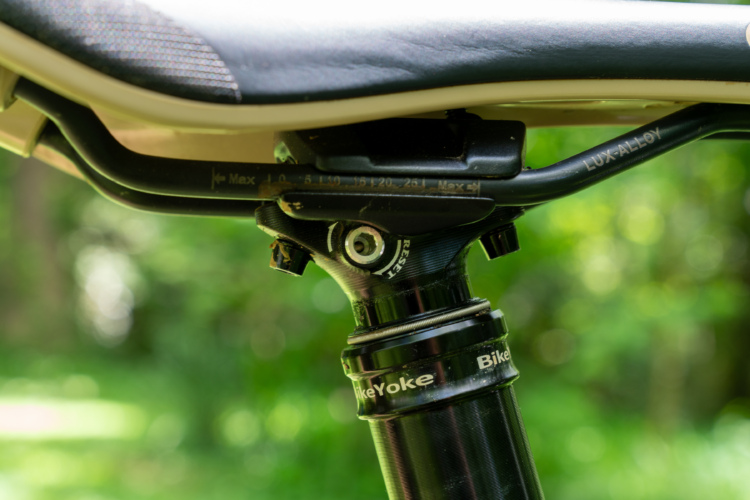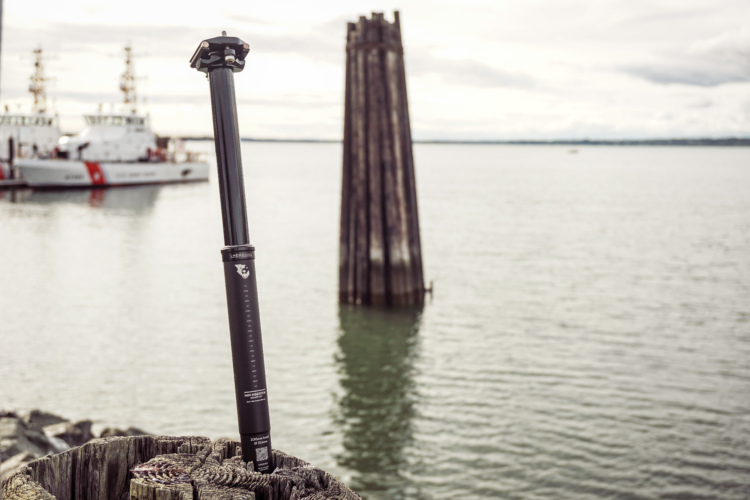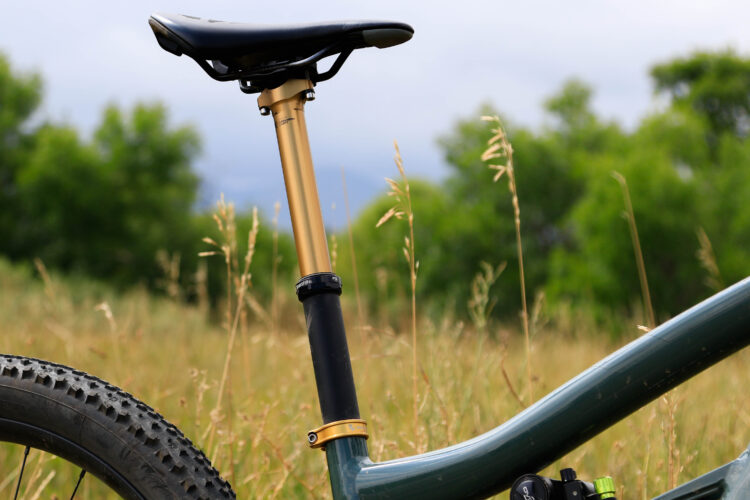
Batteries have been on bikes for a while now, but they’re still the most polarizing topic I see in the mountain bike world. E-bikes, electronic drivetrains, and now electronic seat posts like the Fox Transfer Neo; if it involves electrification, I guarantee people are going to have an opinion.
I was admittedly slow to adopt electronic shifting. In fact, I didn’t so much adopt it as I had it thrust on me when SRAM Transmission came spec’d on a new bike I purchased. Despite my initial misgivings, I’ve had a mostly positive experience. While I’m not rushing out to upgrade all my bikes, I can honestly say I’m excited to see the technology become more of a standard.
When I got the chance to test the new Fox Transfer Neo wireless dropper post, I was again pretty lukewarm about the concept. How was a battery-powered component superior to the slew of proven, mechanically actuated designs on the market? What was the point of another (and different!) battery?
Fox Transfer Neo key specs
- Weight: 62g for remote and clamp, 714g for 30.9x200mm post and battery
- Sizing: 30.9, 31.6, and 34.9mm diameters; travel lengths from 100 to 200mm
- Battery life: ~1,200 activations, 30-40 hours
- Price: $859
- Buy from Jenson USA
I suspected engineers at Fox had been asking those same existential questions themselves. For a company that’s been in the dropper post game for a while, Fox has been a little slow to electrify their staple seatpost. Wireless posts have been around since 2016 at least, the year the Magura Vyron dropped, and SRAM brought a more polished version of the tech to the well-capitalized “masses” when high-end bikes started appearing with the Reverb AXS in early 2019. It may come as a shock, but that was half a decade ago, or one eternity in the bike world.
Instead of speculating about what took them so long, I reached out to Kip Otterness, Design Engineer at Fox, to ask about the development timeline.
“You’re right that the wireless seatpost is something we have been thinking about (and working on) for a very long time,” he said. “We actually had a rideable prototype of an electronic Fox post way back in 2016, but the technology didn’t exist to create a seatpost with what we felt was a sufficiently fast response. If you read reviews of some of the early (and even current) electronic seatposts on the market, it’s clear that response time is critical to a better riding experience. As we worked on this project, the team invented the patented Neo protocol to produce a far quicker response time and the fastest seatpost on the market.”
He continued, “We also needed to design around the total stack height of the seatpost, which is a key constraint and limits how much drop a rider can achieve in a given frame. If we had just thrown a motor onto our 2016 seatpost architecture, we would have added significant length. To work around the added length of the motor, we completely redesigned how our post functions and created the most compact valve that we could. Interestingly, instead of pushing and pulling on this valve like we do in a traditional Fox seatpost, we created a rotary valve that allows us to further reduce stack height by eliminating the need to convert the motor’s rotational output to axial movement.
“Those are just a few of the things we designed around when making the post, but hopefully help better explain why we took the time we did.”
Eight years is a long time, but in my opinion, they’ve delivered a product worth the wait.

Why Wireless?
In my roughly 160 hours on the Transfer Neo, I’ve come to appreciate it for its myriad advantages over mechanical alternatives. In order of most to least impactful, the short lever throw is definitely the place to start. You don’t realize how far you have to push the lever of a cable-actuated dropper until you replace it with a button that activates at a light touch.
If we imagine a perfect world, a dropper post would move up and down with a simple thought. It’s not Neuralink, but Neo is a small but significant step in the right direction. It’s difficult to understand the improvement until you try it on for a while, and I noticed myself using it in places I wouldn’t have previously bothered to “unwrap” my thumb from the bars.
Reliability is the second strength. Throughout my hours of testing, the Neo has simply worked, and it’s done so without all the potential issues that accompany cable routing. Worn cables, fraying cables, rattling cables, loose cable clamps, yanked cable housing in a crash — these problems and more certainly aren’t common enough to cripple the market for traditional droppers, but I’ve run into them all more than a few times. They’re a pain in the ass when you’re out on a long ride, and they can be downright devastating when you’re in the parking lot gearing up for one.
In addition to the functional advantage of reliability, you’ve got to love the clean cockpit provided by a wireless dropper. It won’t be important to everyone, but I’m a huge fan. Less cable clutter is also nice for night riding, allowing your bar light to shine unimpeded on the trail and not reflect even a small amount of light back in your face.
Another advantage to cutting the cord? Your Neo can be used on multiple bikes. Like me, you might need a $10 shim to accommodate different seat tube diameters, but I happily spent that money and 65 seconds moving my post and remote back and forth between two bikes so I could reap the benefits on every ride. This practice will also help make the post’s price a little more palatable if you don’t have $859 burning a hole in your pocket — which is an appropriate segue into the downsides.


Why the Fox Not?
Cost is going to have to do almost all of the heavy lifting in this section. I’ve gotten a complete (gravel) bike for less than the Neo’s MSRP, and even in the world of fancy wireless droppers it’s expensive. The KS Lev Circuit is available for $730, the Reverb AXS can now be had on sale for less than $700, and the TranzX EDP01 retails for $500.
Although Fox has left the door open for a more competitively priced wireless post, it’s telling that the first run of Transfer Neos is sold out on Fox’s website and many other popular retail sites. Build it, and they’ll buy it — even with batteries.

You will have to remember to charge those batteries by the way, albeit infrequently enough that it’s tough to call it a disadvantage. Like the Reverb AXS, the Neo features a 300mah battery that has some serious staying power. Here in the mountains of Western North Carolina, I’ve been getting 30-40 hours of riding time or about 1,200 activations per charge. Your own mileage will vary based on your terrain, with flatter, undulating trails generally requiring a more active left thumb.
Wherever you ride, I’m betting you’ll be pleasantly surprised by battery life. The only time I ran out of juice while riding was an intentional part of my testing. Unfortunately, I had managed to forget the spare I thought was in my pack. Turns out innovation can’t solve user errors. To avoid heading out with no juice, simply press the button on the post collar after you ride. If the light is yellow, you could still get a big ride out of it, but you might as well toss it on the USB-C charger.


From dead, you’ll have a full battery in about 90 minutes. On the lever end, the Neo uses a coin cell CR2032 battery and Fox says it will last about a year. I’ll report back. Conveniently, if the lever battery dies, you can activate the post by holding the button on the collar. Pretty neat.
Share your Fox Transfer Neo review
Finally, if a clean cockpit is a pro, it only seems fair that the blocky collar on the Neo is a con. If you’re curious, Otterness highlights a few different considerations that went into the design:
“Placing the controller and battery at the collar took advantage of space that was already used for the seatpost’s wiper and upper bushing,” he told me. “Because those parts and that section of post were always going to be our limiter for seatpost exposed length, we were able to place our controller and battery in a way where they wouldn’t add much additional stack height. We also focused on this area for battery and controller placement as it was much better for tire clearance. Had we put those parts at the head of the post, they would add stack height and also need to stick out further due to the saddle clamp and seatpost head architecture, potentially resulting in situations where the battery or controller could be hit with the rear tire in a bottom out event.”



While the Neo collar is far from beautiful, I’m happy to report that I’ve become comfortably numb to it and think you will too.
There’s an app for that
If you were wondering how I knew how many activations I was getting per battery, the answer is the Fox Bike App. The app displays your remaining post and remote battery life, and it also tracks your Neo usage in both hours and number of activations. Fox recommends getting the post serviced every 8,000 activations, which translates to a very respectable 275-300 hours in my experience, and you can request service right from the app. They estimate a $115 service charge, although there’s an asterisk there presumably for situations requiring more extensive rebuilds.
Pros and cons of the Fox Transfer Neo seatpost
Pros
- Short lever throw
- No cable issues
- Clean cockpit
- Can switch between bikes
- Long battery life
Cons
- Pricey
- Something to charge, albeit infrequently
- Aesthetic takes some getting used to




Bottom line
If I’ve learned anything from years of testing bike products, it’s that everything is relative. You can be perfectly satisfied with your setup until you throw a leg over someone else’s bike and realize you’ve been living in the Matrix all along.
I’ve used droppers from nearly a dozen brands at this point, and they all checked the box with varying degrees of performance. And yet, now that I’ve been red-pilled by Fox, it’s difficult to imagine going back to a cable-activated dropper from any manufacturer. If you can stomach the price, the Neo will open your eyes and make your ride a little bit better — and I’m here for it.
Additional information
By Jeff Barber
The Kashima-coated Fox Transfer neo post features a rechargeable battery that’s said to deliver 30-40 hours of operation out of a single charge, while the remote uses a watch battery that should last about a year. If/when the remote battery does run out, there is a manual activation mode on the post that will work, just as long as the post battery still has a charge.
In terms of the form factor, Fox has clearly put a lot of thought into the design of the post and lever. The post minimizes overall stack height while the battery and wireless controller are located at the top of the lower post section to maximize tire clearance. And the remote is designed to sit closer to the bar to minimize accidental contact and requires less throw than a mechanical lever for easier operation.

Fox says “non-essential functions of its wireless protocol [were] stripped away in favor of speed,” resulting in a signal that is “100x faster than Bluetooth and 20x faster than our closest competitor” for faster activation and a more responsive post. However, it’s unclear which functions were deemed non-essential, and whether some might include security protocols to prevent malicious tampering.
Since the post is electronic, Fox has added some features you won’t find on a mechanical post like a bike park mode that prevents accidental post extension and an 8,000 activation service reminder based on how often you use the post, rather than a set number of hours. Transport mode puts the post to sleep so that its “Shake to Wake” function isn’t accidentally triggered while driving to the trailhead.
Like the fully mechanical Fox Transfer dropper post, the Transfer Neo features adjustable air pressure through a Schrader valve located at the top of the post. Only the Factory-series will be available for purchase aftermarket, with Performance Elite Series Neo posts available on select complete bike builds from various brands.





















3 Comments
Sep 19, 2024
While Wireless is nice for moving between bikes, it's far from needed...at least until they get a post that can go up and down without having to sit on the post...then I'll be intrigued. I already have two buttons on my left hand with my AXS pod controller. I'd love one for up and one for down
Sep 19, 2024
Feb 8, 2025